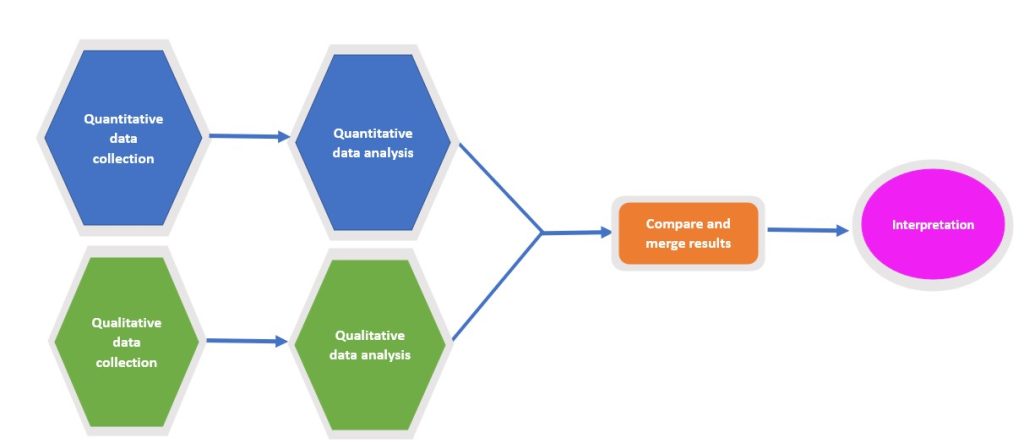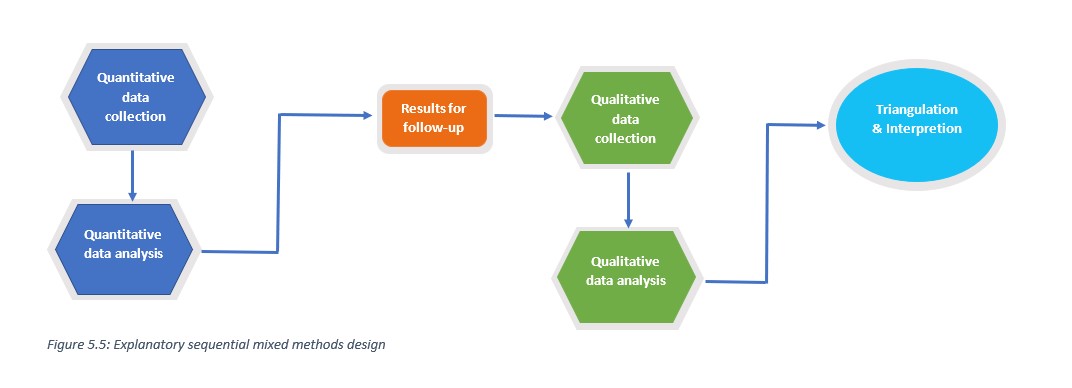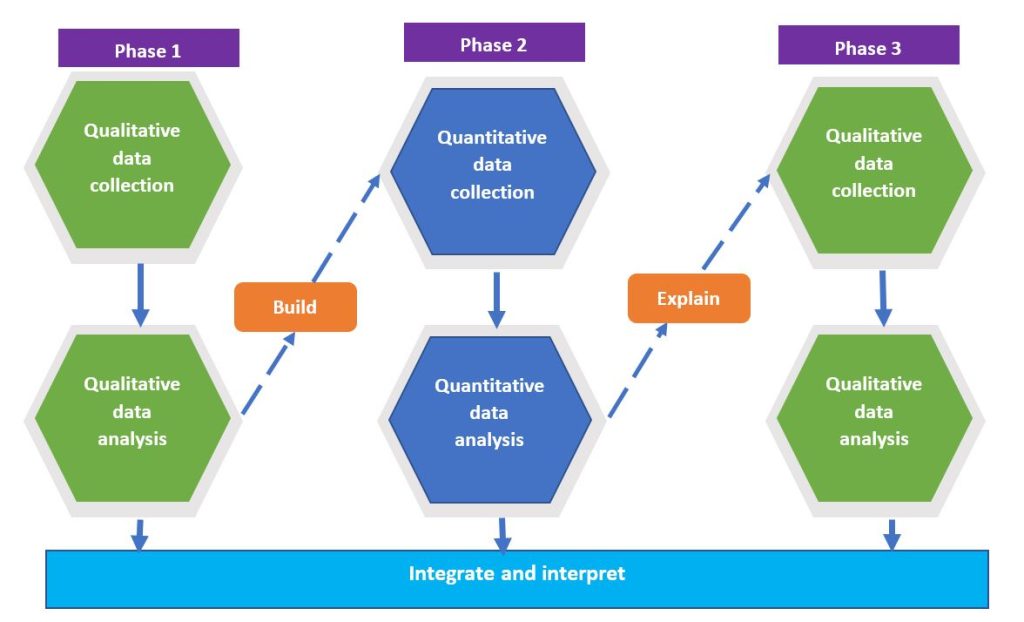5.5 Mixed Methods Study Designs
There are diverse reasons why researchers undertake mixed methods research.10 When researchers commence their study with a quantitative phase before a qualitative phase, often the aim is to use the initial information gathered to identify the best participants who may be recruited in the follow-up qualitative phase or to explain the mechanism behind the quantitative results.10 For research studies where the quantitative phase follows the qualitative phase, the researcher may develop either a survey instrument, an intervention, or a program informed by the qualitative findings/ evidence. The choice of a mixed methods design should be informed by theoretical and/ or conceptual frameworks that support the study aims/ objectives.9
The following mixed methods designs listed below are not exhaustive but only highlight common designs used in health care. Convergent, sequential and embedded are the basic designs, while multiphase goes beyond these basic designs but has been included here for your knowledge.25 It is important to note that there are more complex designs, and the research question drives them.
Convergent (parallel or concurrent) design: A mixed methods design in which quantitative and qualitative data are collected simultaneously but analyzed separately, and the results are merged or integrated (Figure 5.2).25 This type of design allows for the collection of rich, detailed data and provides a comprehensive understanding of the research problem.25 An example of a concurrent mixed method design is the study by Rosenkranz, Wang and Hu., 2015 which aimed to explore, identify and explain what motivates and demotivates medical students to do research. The study used a convergent parallel mixed methods study where quantitative data were collected via a survey and qualitative data via semi-structured interviews. Data were analysed separately, and the results were compared and merged.26
The benefit of the convergent mixed methods design used in the study by Rosenkranz et al.,26 is that it allowed for a more comprehensive and nuanced understanding of what motivates and demotivates medical students to do research by drawing on both types of data. The survey results showed that students who had experienced exposure to the uncertainties of clinical practice through clerkships and supported compulsory research activities, were more likely to view future research activities positively. The semi-structured interviews revealed that these activities were particularly important because they helped the students to see research as a social activity which has clinical relevance and builds confidence. Overall, the study design provided evidence for the motivating effects of Competence and Relatedness in relation to medical students doing research. In this particular study, the researchers were able to not only identify the factors that motivate and demotivate medical students to do research but also gain an in-depth understanding of why those factors were important. The study design also increased the validity of the research as the limitations of the survey data were addressed by using qualitative data to provide a more in-depth understanding of the research question.

Sequential (exploratory or explanatory) designs: In this type of mixed methods design, the aim is to use the results of one method to develop or build another method. These designs may begin with a qualitative method followed by a quantitative approach (exploratory) or a quantitative investigation followed up with a qualitative enquiry (explanatory).25
Exploratory sequential design: This technique involves the initial collection of qualitative data, and the findings are used to guide the design and development of quantitative data collection tools.25 The quantitative and qualitative data results are then integrated to provide a more comprehensive understanding of the phenomenon (Figure 5.3). This method is useful when developing and testing a new instrument. An example is the study by Jafer et al., 2020 which investigated dental patients’ behaviour, thoughts, opinions and needs for oral cancer information, and dentists’ behaviour regarding the prevention and examination of oral cancer.27 The qualitative methodology was utilised to discover the emerging patterns in the patient’s thoughts, opinions and expectations regarding oral cancer. Following the qualitative investigation, a descriptive quantitative observational study was conducted on a larger sample of dental patients to analyse and quantify oral cancer-related features.27
The benefit of using an exploratory sequential design in the study by Jafer et al.,27 is that it allowed for an in-depth exploration of the dental patients’ thoughts, opinions, and needs for oral cancer information, and dentists’ behaviour regarding the prevention and examination of oral cancer. By using qualitative methods to explore the emerging patterns in the patients’ views and needs, the researchers were able to identify key themes and issues that would have been missed in a purely quantitative study. The subsequent quantitative study, which involved a larger sample of dental patients, allowed the researchers to test and confirm their findings from the qualitative study in a more representative sample. By combining both qualitative and quantitative methods, the researchers were able to gain a more comprehensive understanding of the research problem and provide more nuanced and insightful recommendations for improving oral cancer prevention and examination practices in dental settings.

Explanatory sequential design: this method is characterised by the collection and analysis of quantitative data, followed by the collection and analysis of qualitative data.25 The goal is to use the qualitative findings to explain and interpret the quantitative results (Figure 5.4). This method is popular in health research.25 An example of explanatory sequential design is the study by Albert et al., 2022 which explored the views of General Practitioners (GPs) and Exercise Physiologists (EPs) as key stakeholders for optimizing patient care and efficiency of physical activity referral schemes (PARS).28
The authors used quantitative methods to investigate these health professionals’ knowledge, beliefs, and attitudes towards PARS in the first phase of the study. This initial phase provided an overall understanding of the topic, indicated that the participants valued PARS and the findings guided the development of the interview guide and participant selection for the second (qualitative) phase. In the second phase, the authors used semi-structured interviews to gather in-depth information on participants’ perceptions about care coordination through PARS. The qualitative data allowed for a more nuanced understanding of the research question and helped the researchers to identify the key factors that influence the success of PARS. This design helped the authors to develop a robust and accurate understanding of a complex phenomenon and provided insights that can inform the development of interventions and policies to improve patient care and the efficiency of PARS.

Embedded design: This design is also known as nested design.25 It involves embedding one research design into another to generate new insights (Figure 5.5). Embedded designs may be convergent or sequential.25 As an illustration, this technique could embed qualitative research within a broader quantitative study.25 The quantitative study is used to offer a larger understanding of the research problem, whereas the qualitative study provides a more in-depth understanding of specific parts of the research topic.25 An example is the study by Yue et al., 2022 which aimed to investigate nurses’ perceptions and experiences with the transition to a new nursing information system (Care Direct) 2 years after its first introduction. The study used an embedded design in which qualitative data and quantitative data were collected concurrently with the qualitative data given priority.29
The embedded mixed methods design allowed the authors to explore both the prevalence of certain attitudes or behaviors and to gain insight into why these attitudes and behaviors were present. The use of qualitative data as a priority in the study allowed the researchers to explore the complexity and richness of the nurses’ experiences with the new system. This approach is particularly useful when trying to understand the factors that contribute to or impede successful implementation of new technologies. Additionally, the qualitative data was used to develop a theoretical framework that informed the development of the quantitative survey instrument. This strategy ensured that the quantitative data collected was grounded in the context of the nurses’ experiences with the new system, thereby enhancing the quality and relevance of the research findings.

Multiphase design: In this approach, multiple projects with a common goal are conducted.25 This method requires multiple designs to be conducted over time with linkages in place to ensure that each phase builds on the previous one.25 A project could start with a qualitative design and proceed to a quantitative design, then return to a qualitative design, and so on (Figure 5.6). The design may contain convergent or sequential elements.25 For example, Lee et al., 2018, conducted a study that sought to evaluate an intervention program – The Prevention and Wellness Trust Fund (PWTF).30 The program was designed to address hypertension, paediatric asthma, falls among older adults, and tobacco use in Massachusetts. The aim was to improve health outcomes through prevention and disease management strategies and reduce healthcare costs.30 A multi-phase, explanatory sequential mixed methods design (qualitative to quantitative to qualitative) was used to gain a more comprehensive understanding of the implementation of the Prevention and Wellness Trust Fund interventions.30
The multi-phase, explanatory sequential mixed methods design used in this study enabled the researchers to provide a more holistic, comprehensive, and actionable evaluation of the PWTF intervention program. The findings from the study can help program developers and policymakers to identify the most effective strategies for addressing the target health issues and design programs that are sustainable and cost-effective.


